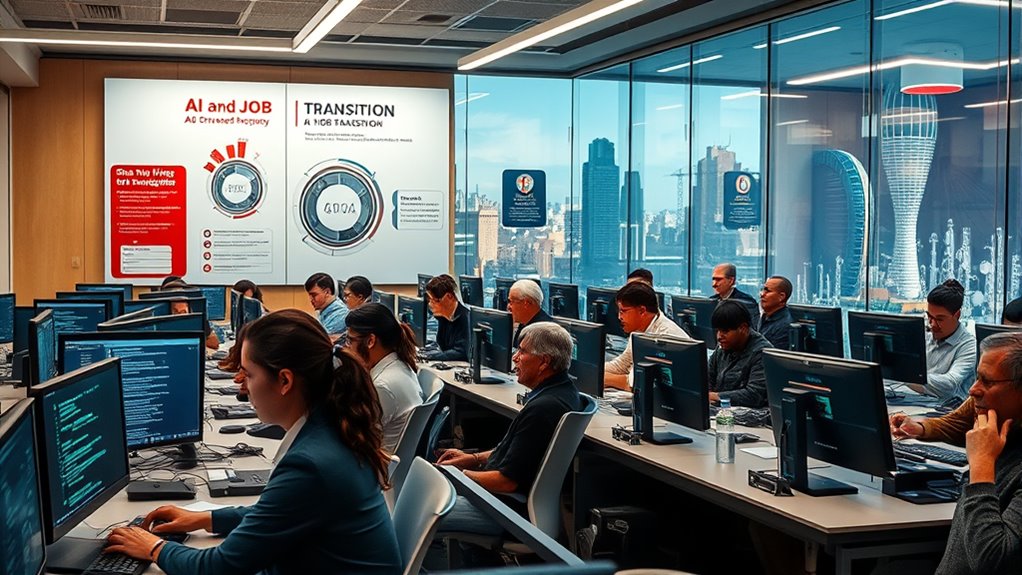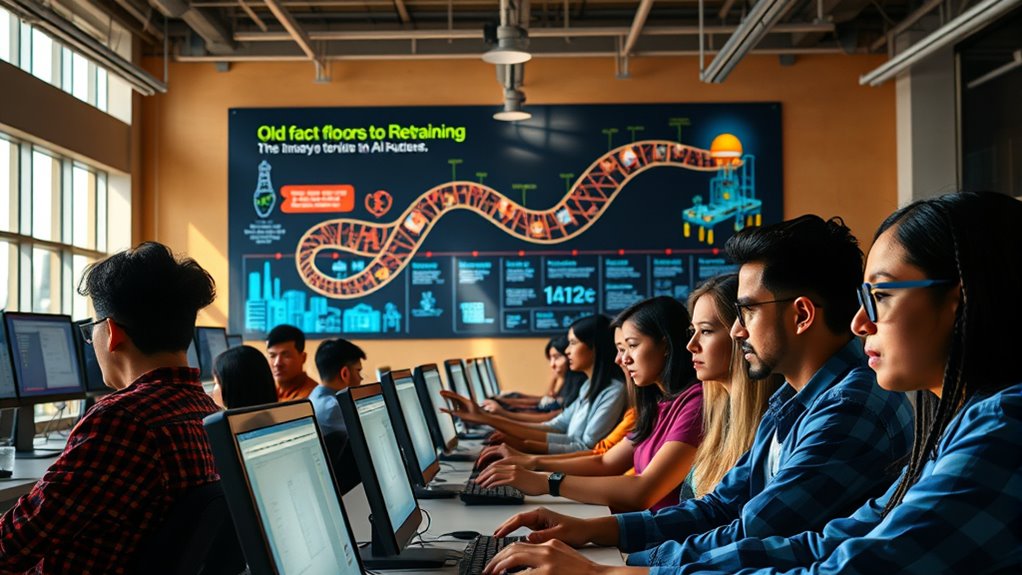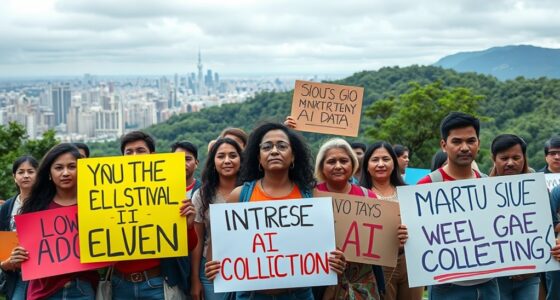Retaining everyone for the AI-driven economy is a huge challenge. Up to 800 million jobs could be replaced by 2030, and millions are already displaced. While skills like AI literacy, critical thinking, and soft skills are needed, rapid technological change outpaces retraining efforts. Governments and organizations are working on new programs, but gaps remain. If you want to understand whether we can truly keep up with this shift, keep exploring the options ahead.
Key Takeaways
- Workforce disruption from AI threatens millions of jobs, making universal retraining a significant challenge.
- Resource limitations, resistance, and fragmented systems hinder large-scale retraining efforts.
- Rapid technological change outpaces current training programs, risking unpreparedness in the workforce.
- Lifelong learning and adaptable policies are essential but may not be sufficient for everyone to transition smoothly.
- Strategic investments and innovative programs can help bridge the gap, but complete retraining of all workers remains uncertain.
The Scale of Workforce Disruption

The scale of workforce disruption caused by AI is staggering and rapid. By 2030, up to 800 million jobs worldwide could be replaced, affecting nearly 60% of jobs in advanced economies. You might see 45 million American jobs overtaken by AI, and currently, 14% of workers have already experienced displacement. AI’s economic impact could reach $15.7 trillion, highlighting its transformative power. Businesses aren’t standing still—half have integrated AI, yet only 1% feel their implementation is mature. The skills you use may change drastically; by 2030, 70% of job skills will evolve. Resources and Tools can help individuals adapt to these rapid changes. Honda Tuning technologies and modifications exemplify how industries adapt to changing performance demands, akin to workforce adaptations. High impact on employment New approaches to work environments and productivity will be essential as the landscape shifts. Over 120 million workers are expected to retrain soon, the disruption is widespread, affecting individuals, industries, and economies on an unprecedented scale. Additionally, ongoing research into AI vulnerabilities underscores the importance of developing robust safety measures to manage these technological transformations effectively.
Challenges in Implementing Retraining Programs

Implementing retraining programs faces a range of significant challenges that can hinder their success. Budget constraints limit organizations’ ability to cover costs, while resource limitations divert focus from training initiatives. Investment priorities often favor capital over labor, and public funding gaps restrict program scope. Additionally, ineffective training—due to poor engagement or underused AI tools—further hampers outcomes. Resistance from employees and management, along with fears about job security, create participation barriers. Access issues arise as many organizations lack mature AI training, especially for vulnerable populations or older workers. Scaling programs is difficult because of fragmented systems and the risk of reinforcing inequalities through biased AI. Moreover, the lack of standardized training curriculums complicates efforts to provide consistent skills development across sectors. To address these issues, developing comprehensive training frameworks that are adaptable and inclusive is essential for broader success. Building a foundation of shared educational standards can help streamline efforts and ensure quality across different programs. Recognizing the importance of diverse training methods can further enhance engagement and learning outcomes in various organizational contexts.
Skills Needed for the AI-Driven Job Market

As AI transforms the workplace, developing the right skills becomes essential for staying competitive. You need AI literacy—understanding its principles, data interpretation, and ethical considerations. Critical thinking helps you analyze AI outputs and make informed decisions, while communication skills enable you to share findings effectively. Technical skills are *imperative* too, including programming in Python or R, grasping math and statistics, and understanding machine learning concepts. Specializations like natural language processing, computer vision, and neural networks are increasingly valuable. Soft skills, such as adaptability, collaboration, problem-solving, and creativity, are *indispensable* for integrating AI into workflows. Additionally, familiarity with the Predictive Modeling in Educational Data Mining can give you insights into how data analysis supports decision-making and personalized learning strategies. Developing AI literacy is crucial for understanding how these technologies impact various industries and societal structures. Staying informed about ongoing AI in Education developments can help you anticipate future trends and adapt your skill set accordingly. Moreover, understanding the regulatory environment surrounding AI can help you navigate compliance and ethical challenges as these technologies evolve. Whether in healthcare, finance, education, or manufacturing, mastering these skills will help you thrive in the evolving AI-driven economy.
Role of Education and Policy in Workforce Transition

Education and policy play crucial roles in guiding the workforce through the AI-driven transformation. You should recognize how they shape skill development and accessibility. First, you’ll see that 77% of higher education faculty plan to adopt AI tools to enhance learning, making training more effective. Second, targeted programs like AI-focused CTE and scalable retraining initiatives are emerging to meet the urgent demand, with federal grants supporting their expansion. Third, policies now emphasize lifelong learning, public-private partnerships, and inclusive frameworks that aim to bridge digital divides. These efforts ensure that workers gain relevant skills and remain adaptable. Additionally, skill overhauls are being prioritized in policy frameworks to ensure that the workforce can keep pace with rapidly evolving technology requirements. Moreover, studies suggest a correlation between astrological signs and perceived ability to adapt, which can influence workforce confidence. Incorporating personality assessments into training programs can further tailor support for diverse learners. Recognizing the importance of environmental considerations, many initiatives now include sustainability and eco-friendly practices to promote responsible technology adoption. For example, integrating sustainable practices into tech development can help mitigate environmental impact. Furthermore, understanding the role of digital literacy in workforce readiness is essential for designing effective retraining programs. Ultimately, education and policy are the backbone of a resilient workforce, helping you prepare for the rapid changes brought by AI advancements.
Can We Bridge the Gap in Time?

The rapid pace of AI advancements is forcing industries and workers to adapt faster than ever before, creating a pressing challenge to bridge the time gap for retraining. Technologies like generative AI are transforming sectors swiftly, leaving little time for workforce adjustment. While AI is expected to create 170 million new jobs by 2030, the current job market is evolving faster than retraining efforts can keep up. Companies face the dilemma of preparing workers for roles that may not yet exist, amid economic uncertainties and structural trends like aging populations and e-commerce growth.
| Challenge | Opportunity |
|---|---|
| Rapid technological change | Accelerates digital transformation |
| Evolving job market | Promotes skills enhancement |
| Workforce readiness delays | Creates new roles and industries |
| Economic uncertainty | Inspires innovative retraining strategies |
| Occupational shifts | Demands adaptable, lifelong learning |
Frequently Asked Questions
How Can Smaller Businesses Afford Large-Scale Retraining Efforts?
You might think large-scale retraining is out of reach for your small business, but affordable options exist. Leverage community colleges, online courses, and virtual training to cut costs. Focus on microlearning and peer-to-peer support to maximize impact with less time and money. Partner with local educational programs for subsidies, and use scalable digital platforms to train efficiently. These strategies can help you retrain staff without breaking the bank.
What Mental Health Support Is Available for Displaced Workers?
You have access to various mental health supports for displaced workers, like individual counseling and group therapy, which help process emotions and reduce isolation. Workforce resilience workshops build emotional strength and stress management skills. Community outreach guarantees you know where to find mental health resources, while partnerships with organizations provide additional support. These services aim to help you adapt emotionally, fostering resilience during challenging transitions and promoting overall well-being.
How Will AI Affect Job Quality and Worker Satisfaction?
AI can improve job quality by automating routine tasks, reducing stress, and allowing you to focus on more meaningful, complex work. It may boost your job satisfaction through increased engagement and opportunities for skill development. However, it also demands that you continuously learn new skills, like AI literacy, to stay relevant. Overall, AI has the potential to enhance your work experience, but adapting will be key.
Are There Ethical Concerns in Retraining for Ai-Related Roles?
You might wonder if retraining for AI roles raises ethical concerns. It does, because ensuring fair access and respecting workers’ dignity matter. Employers and governments have an ethical duty to provide equitable retraining opportunities, especially for marginalized groups. Without this, long-term unemployment and social inequalities grow. You should advocate for policies that support inclusive upskilling, balancing efficiency with respect for human rights and ensuring nobody’s left behind in the AI-driven economy.
How Can International Cooperation Enhance Global Workforce Transition Efforts?
International cooperation acts as a bridge connecting countries in workforce shift efforts. You can benefit from shared standards, joint research, and global training programs that make skill development a smoother ride across borders. By aligning regulations, sharing data, and creating international initiatives, you’re boosting talent mobility and innovation. This collective approach helps guarantee everyone’s skills stay relevant in the rapidly evolving AI economy, turning a formidable challenge into a shared opportunity.
Conclusion
You stand at the crossroads of change, facing a shifting landscape where retraining is the bridge between today and tomorrow. While the road ahead is steep and winding, your efforts can light the way like a lighthouse guiding ships through darkness. It’s a tall order, but with determination and collective will, you can turn this turbulent tide into a voyage of renewal. The future isn’t set in stone; it’s yours to shape, one skill at a time.









